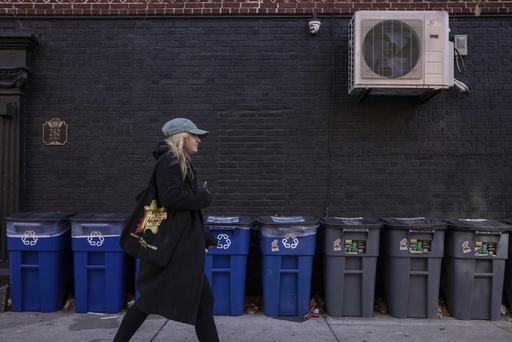NEW YORK — For the last fifty years, residents of New York City have disposed of their waste using plastic bags filled with garbage tossed directly onto the sidewalks.
However, these bags often tear or leak, spreading litter across the streets and attracting rats to feast on the leftovers. During winter months, these piles of trash are buried under snow, causing them to remain frozen for extended periods, further harming the city’s reputation for cleanliness.
Transitioning to a new waste disposal system, New Yorkers are gradually adapting to a system where trash is placed in bins with lids. This change became mandatory earlier this month for all residential buildings with fewer than ten units, which constitutes a large portion of the city’s residences. Businesses were required to switch to bins earlier this year.
Jessica Tisch, who has recently stepped down as the city’s sanitation commissioner to assume the position of police commissioner, stated that this shift may sound outrageous to those from different urban areas, but it marks a significant change for New York City. “For fifty years, we have placed all our trash directly on the curbs,” she noted.
Residents who have witnessed similar practices in other cities believe that New York was overdue for this modernization. John Midgley, a Brooklyn brownstone owner with experience living in cities like London, Paris, and Amsterdam, shared his frustrations over the sight of rotting food protruding from broken bags. “The stink builds up, you know, week after week after week,” he remarked.
Currently, New York City’s homes, businesses, and various institutions produce approximately 44 million pounds (20 million kilograms) of waste daily, with about 24 million pounds (11 million kilograms) collected by city sanitation crews, while the remainder is handled by private waste collectors.
Historically, New York mandated the use of metal trash cans early in the 20th century, but prior to the widespread adoption of plastic bags, refuse was simply tossed into these bins, resulting in unsightly conditions.
The turning point came in 1968 when sanitation workers went on strike, leaving trash to overflow from cans and accumulate on sidewalks, resulting in a chaotic and unkempt state reminiscent of a dystopian scene. To help rectify the situation, plastic bag manufacturers stepped in with donations, which led to a change in waste management habits.
Steven Cohen, a dean at Columbia University with a focus on public affairs, believes convenience played a significant role in the shift. After the strike, sanitation workers preferred the modern convenience of lighter, sealed plastic bags that kept odors contained better than metal bins.
In response to increasing concerns about the city’s rat population, Mayor Eric Adams’ administration has labeled the heaps of trash bags as a significant issue in the ongoing fight against vermin. Plastic bags provide easy access for rats, while secure bins with locking lids are expected to be more effective at deterring them.
The new bin requirement, which was enacted on November 12, presents its own challenges, particularly in residential areas lacking yards or alleyways to store large wheeled bins. Landlords and homeowners are also faced with the responsibility of returning empty bins from the curb—a task that plastic bags did not require.
Manhattan resident Caitlin Leffel mentioned the increased costs associated with hiring someone to manage the bins’ mobility several times a week. “The way this program has been rolled out has not taken into account many of the nuances of living in New York City,” she expressed.
Building superintendents have raised concerns about the additional responsibilities placed on them due to the new regulations. Dominick Romeo, founder of NYC Building Supers, highlighted the profound changes this implementation has introduced to their daily routines. “It’s completely rearranged our lives,” he said, as many staff members scramble to adapt.
In time, larger residential buildings consisting of more than 31 units will be assigned designated containers on the street, while new trash trucks equipped with automated, side-loading arms—an upgrade seen in several other nations—will facilitate collection.
According to Harry Nespoli, head of the union for about 7,000 city sanitation workers, these enhancements should simplify and tidy up the collection process, although this shift may lengthen the time taken for waste clearance.
At this stage, sanitation workers continue to manually dispose of trash into trucks, which presents its own set of challenges. “Some places aren’t even using bags,” Nespoli noted. “It will take time for everyone to adapt to this new approach, but ultimately, it’s our job to collect the waste.”
Tisch remains optimistic that New Yorkers will eventually embrace these changes. Currently, city officials are issuing written warnings to those not adhering to the new rules, which many residents are still unaware of. Starting January 2, penalties ranging from $50 to $200 will be enforced for noncompliance.
In her closing remarks, Tisch mentioned, “No one wants to live on a dirty block. No one wants to walk past a heaping mound of trash and trash juice when they are leaving for work or walking their kids home from school.”
This website uses cookies so that we can provide you with the best user experience possible. Cookie information is stored in your browser and performs functions such as recognising you when you return to our website and helping our team to understand which sections of the website you find most interesting and useful.
